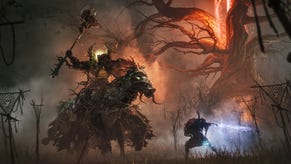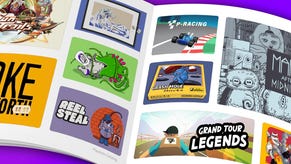What makes a good Kickstarter campaign?
Anya Combs talks about ideal video length, the right number of .gifs, and one mistake that will keep any project from being featured
The days of every veteran developer launching a Kickstarter to make spiritual successors to their greatest hits may be behind us, but the crowdfunding platform is still a viable option for plenty of developers in need of funding. At the GamesIndustry.biz Investment Summit at PAX East last week, Kickstarter's Anya Combs offered those developers some context on how video game projects are doing, and advice on how they can maximize their projects' chances of success.
Combs began with an overview of the games category on Kickstarter, which is likely to pass a cumulative $1 billion pledged this year. Between video games, tabletop games, card games, live-action role-playing projects and others, the games category has attracted 3.2 million backers, with 38% of projects reaching their funding goal.
As for video game projects specifically, Combs said they reach their funding goals about 21% of the time, a rate that has been mostly consistent since 2012. To date, video game projects have seen 1.6 million backers pledge a total of $234 million to roughly 12,800 projects.
"Gameplay is key on Kickstarter... 30 seconds is all you need. But you need to be able to show it"
Combs also revealed some numbers for tabletop games on Kickstarter, which also have seen 1.6 million backers, but boast a pledge total of $675 million across 18,900 projects, and have seen a significantly higher 58% success rate.
So how can game developers ensure they're among those successfully funded projects? It starts with a good pitch video, and a good pitch video needs to showcase the game being pitched.
"Gameplay is key on Kickstarter," Combs said. "You need to show your gameplay, especially for a video game. You don't need to show hours of footage or anything like that. 30 seconds is all you need. But you need to be able to show it."
Developers don't need professional video production behind the video -- filming it on an iPhone is "totally fine," Combs said -- but they do need to sell the game and themselves efficiently. Combs suggested two minutes as an ideal length for a pitch video, split between 30 seconds of gameplay, 30 seconds explaining who the people behind the game are, 30 seconds explaining why the team is on Kickstarter, and a final 30 seconds of more gameplay, bloopers, or other miscellaneous content about the game.
Sometimes a developer doesn't even need to hit all those bases. Combs pointed to the pitch video for Night in the Woods as a particularly effective example of the form, even though it runs a lean 1:14 and doesn't bother explaining why the developers turned to Kickstarter for funding at all.
Community building is also essential for any project on Kickstarter.
"You can anticipate about 30% of your pledges are going to come in through Kickstarter," Combs said. "That means 70% of your pledges need to come from a community you build. If you are here at PAX, you're building a community. Get people to sign up for your mailing list. Get people to come to your Discord. Get people to follow you on Twitter. Build that community."
Crowdfunding campaigns can also be arduous affairs, and Combs suggested limiting their length.
"Your project should only be 30-35 days," she said. "The 60-day project nonsense? Don't do it. It's so long. 60 days is too long for your backers and it's too long for you."
A strong top project image and four or five gameplay .gifs can help get a campaign featured
The reason Combs gave that range of length is because developer may want to shorten or lengthen their campaigns to avoid beginning or ending them on a Friday, Saturday, Sunday, or major US holiday. Even for people who aren't based in the US, Combs said most of the Kickstarter community comes from the US, so Memorial Day, Indigenous People's Day, and other holidays are bad times to start or end a campaign because most people aren't going to be online for it.
She also advised against launching a project with stretch goals already posted, and suggested that developers update their projects for backers every other day, even if it's just to share what they worked on that day or a piece of concept art from earlier in development.
"It can be very, very simple updates," Combs said. "Basically what you're saying to your community is, 'Hey, I'm giving you information. I'm a part of this. I'm still working on it.'"
Naturally it also helps to become a featured project on Kickstarter, and while Combs is not part of the editorial team that makes those decisions, she knows what that group is looking for. For example, Combs said the editorial team likes to see a strong top project image, something that highlights an awesome game rather than a photo of the developers involved. She also endorsed the use of gameplay .gifs, perhaps four or five of them scattered throughout the page.
Combs also recommended developers speak with her and the rest of the games team early and often.
She explained, "If you get me your project page three weeks before you launch, that means I can go to our editorial team and say, 'Hey, what can we do for a promotional page for this creator?'"
As for things to avoid, badges that say "now live on Kickstarter," "funded on Kickstarter," or similar are frowned upon as redundant.
"Our editorial team hates them," Combs stressed. "If you put these types of badges on your project page, our editorial team will completely ignore you. Please do not put them on your project page."
Finally, Combs cautioned developers not to get discouraged if their projects aren't instantly funded. Every project hits a plateau after the first couple of days, and often they bring in the bulk of their money in the final two days of the campaign. And even if a funding goal isn't reached, the campaign doesn't have to be a total wash.
"The only time you fail on Kickstarter is if you haven't learned something from running your project," Combs said. "I've had multiple people who weren't funded the first time around, but maybe they were funded the second time, found a publisher, or realized they needed to build community."









